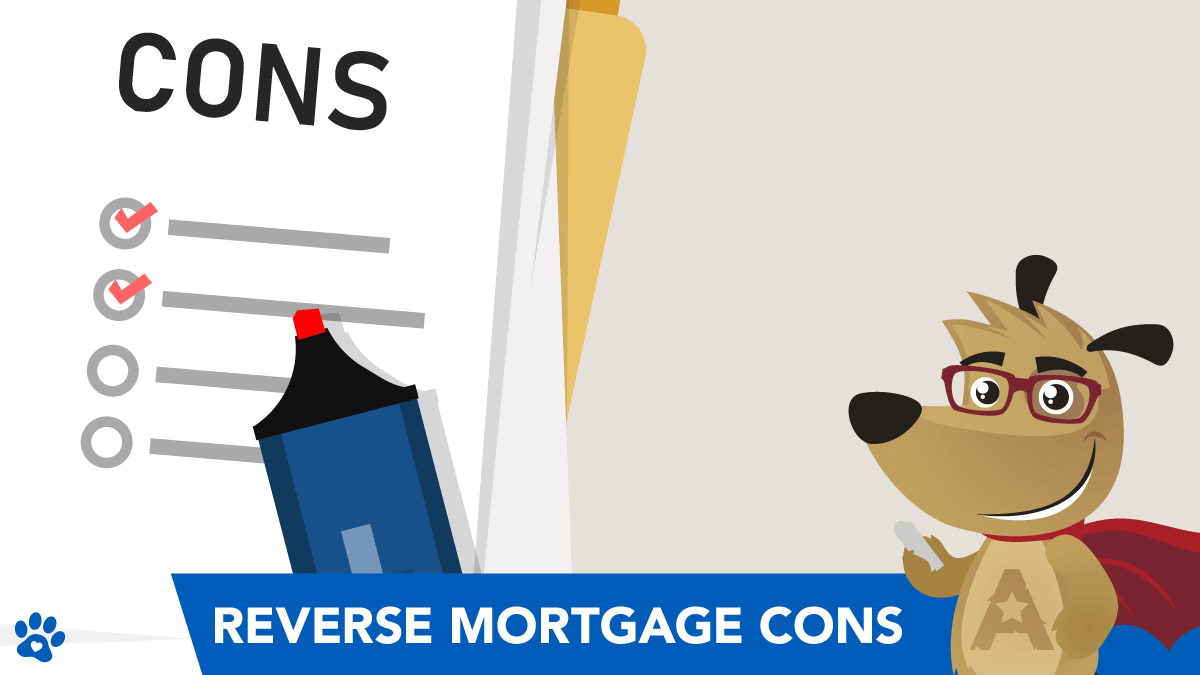
Reverse Mortgage Pros and Cons

 |
ARLO™REVERSE MORTGAGE
ASSISTANT |
Reverse Mortgage Pros and Cons in 2025 | Costs, Risks, Benefits Explained
 |
Michael G. Branson, CEO of All Reverse Mortgage, Inc., and moderator of ARLO™, has 45 years of experience in the mortgage banking industry. He has devoted the past 20 years to reverse mortgages exclusively. (License: NMLS# 14040) |
 |
All Reverse Mortgage's editing process includes rigorous fact-checking led by industry experts to ensure all content is accurate and current. This article has been reviewed, edited, and fact-checked by Cliff Auerswald, President and co-creator of ARLO™. (License: NMLS# 14041) |
Reverse Mortgage Pros and Cons at a Glance
Most homeowners who come to us want one thing: a clear, honest look at whether a reverse mortgage will strengthen their retirement or create risks they don’t need. Below you’ll find a quick summary of the most important pros and cons, including a side-by-side comparison table, followed by a deeper explanation of how each one works in real life. Our goal is to give you the facts in plain English so you can decide what’s right for your long-term plans.
Pros of a Reverse Mortgage
• No monthly mortgage payments required
• You keep the title and can stay in the home as long as program rules are met
• FHA insurance protects you and your heirs from owing more than the home is worth
• Line of credit grows each year and cannot be frozen or reduced
• Flexible payout options for budgeting, health care, or emergencies
Cons of a Reverse Mortgage
• Loan balance grows as interest and FHA mortgage insurance accrue
• You must continue paying property taxes, homeowners’ insurance, and maintenance
• Closing costs can be higher than a traditional mortgage
• Leaves less remaining equity for heirs
• Benefits are limited if you expect to move or sell soon
What are the pros and cons of a reverse mortgage? A reverse mortgage, also known as a Home Equity Conversion Mortgage (HECM), allows homeowners aged 62 and older to convert their home equity into cash without making monthly mortgage payments. It can be a powerful way to stay in your home and improve retirement security, but it’s not the right fit for everyone. This guide breaks down the real pros and cons of reverse mortgages in simple terms so you can decide whether this loan works for your long-term retirement plans.
| Feature | Pros | Cons |
|---|---|---|
| Monthly Payments | No required monthly mortgage payments | Must still pay taxes, insurance, and maintain the home |
| Access to Equity | Flexible, tax-free funds (lump sum, monthly, or line of credit) | Large withdrawals kept in bank accounts can affect Medicaid/SSI |
| Heirs & Estate | Non-recourse: heirs never owe more than the home’s value | Reduces remaining equity; under-62 spouses have limitations |
| Upfront Costs | Minimal out-of-pocket; costs can be financed | FHA insurance makes closing costs higher than many traditional loans |
Is a Reverse Mortgage a Good Idea?
Good fit:
• You plan to stay in your home long term.
• You want to access your home equity without required monthly mortgage payments.
• You like the safety of a line of credit you can draw on as needed (and that is guaranteed for life).
• You want a safety net for the unexpected, desire funds for home repairs, or additional cash flow.
Not ideal:
• You’re likely to move or sell in the near future.
• You will still have trouble maintaining taxes, insurance, and upkeep.
• Your main goal is to leave the home free and clear for heirs.

Reverse Mortgage Pros
Eliminating Monthly Mortgage Payments
One of the most appealing benefits of a reverse mortgage is the elimination of monthly mortgage payments.
However, it’s important to note that while monthly mortgage payments are not required, borrowers are responsible for paying ongoing property charges such as taxes and insurance on time.
Compared to traditional forward loans, reverse mortgages require less income to qualify, making them a more accessible option for many homeowners.
Did You Know? While reverse mortgages eliminate monthly mortgage payments, you still own your home and must continue paying taxes, insurance, and HOA dues (when applicable).
Unrestricted Use of Tax-Free Funds
A significant advantage of reverse mortgages is the unrestricted use of funds. Borrowers have the freedom to choose how they receive their funds, with options including a single lump sum payment, a flexible line of credit, monthly payments for a set term or for life, or a combination of these methods.
An overlooked benefit of reverse mortgage proceeds is that they are considered tax-free. This aspect significantly enhances their appeal, offering borrowers a financially efficient means to access their home equity without the typical tax implications associated with income. The tax-free nature of these funds, combined with the flexibility in their usage, makes reverse mortgages a powerful tool for financial planning and meeting diverse personal needs.
Tip! As always, it’s advisable to consult with a tax professional to understand the specific implications for your financial situation. To better understand how a reverse mortgage can benefit you, try our reverse mortgage calculator to receive instant quotes and explore various Home Equity Conversion Mortgage (HECM) loan options.
Did You Know? Reverse mortgage proceeds are considered to be tax-free, giving borrowers the freedom to use funds in the way that best supports retirement.
Lifetime Security: The Security of a Reverse Mortgage Line of Credit
The reverse mortgage line of credit offers a unique benefit of lifetime security, a feature particularly valuable in uncertain financial times. Under this loan agreement, as long as you have remaining funds in your line of credit and adhere to your loan obligations, HUD guarantees these funds will always be available.
This assurance is a significant advantage over traditional Home Equity Lines of Credit (HELOCs), which banks can freeze or eliminate without prior notice. Additionally, HELOCs typically have a “draw period,” after which the repayment phase begins, potentially leading to significantly higher payments at a time when your income might be lower.
You have the comfort of knowing that no matter how long you reside in your home, how many withdrawals you make, or what happens to real estate values, you will not be forced to sell your home to repay the loan due to an outstanding balance.
Did You Know? Unlike a traditional HELOC that banks can freeze, a reverse mortgage line of credit is guaranteed by HUD and cannot be reduced as long as you continue to meet your loan obligations.
Also see: Reverse Mortgage vs. HELOC and Home Equity Loans
Using a Reverse Mortgage to Buy a New Home
A reverse mortgage offers a versatile solution for refinancing an existing mortgage and purchasing a new home.
This can be a game-changer for those who:
- Are looking to buy a home.
- Need a home that better suits their current needs.
- Aim to reduce their living expenses.
Historically, older buyers looking to purchase homes often faced the challenge of paying in cash due to limited income options. This requirement made it difficult for many to consider various housing choices.
Now, with the availability of reverse mortgages for home purchases, seniors have a much more flexible option. They can use a reverse mortgage to buy their new home without the need for monthly mortgage payments. This means that seniors who cannot pay all cash or who prefer not to exhaust their savings from selling their previous home can purchase a new home more feasibly.
This financial tool is particularly beneficial for seniors eyeing homes in 55+ communities or other desirable locations. Prices in these areas might have been prohibitive under traditional cash-only or high mortgage payment scenarios. With a reverse mortgage, these homes become much more attainable.
Furthermore, for seniors who need to relocate for better access to services, family, or friends, a move that might have been unfeasible with a traditional loan becomes possible with a reverse mortgage. This option offers improved living situations, aligning with their changing needs and lifestyle preferences.
Did You Know? The HECM for Purchase program lets you buy a new home without required monthly mortgage payments or having to pay all cash, opening doors to downsizing, ‘right sizing’, relocating, or moving closer to family.

Reverse Mortgage Cons
Higher Initial Costs
Reverse mortgages, particularly the HECM (Home Equity Conversion Mortgage), often come with higher costs compared to traditional loans. One significant expense is the FHA mortgage insurance. Borrowers are required to pay a 2% upfront fee and a recurring annual mortgage insurance premium (MIP) of 0.50%. This insurance safeguards both borrowers and lenders from default risks, ensuring that neither borrowers nor their heirs will owe more than the home’s value, regardless of fluctuations in loan balances or potential decreases in property values.
While these costs are not paid out of pocket, they can be a considerable downside, particularly for homeowners who are sensitive to closing costs. Although lender credits can sometimes offset these expenses, their availability has diminished significantly since the interest rate hikes and inflation of 2022-2023. However, it’s worth noting that the landscape may change as we move into 2026, and such credits could become available again as interest rates begin to ease. Therefore, shopping around and staying informed about any lender credits that could reduce your costs is advisable.
Considering a proprietary or jumbo reverse mortgage might be wise for homeowners with high-value properties, especially those exceeding the current lending limit of $1,249,125. These properties do not gain additional benefits from values beyond the HUD limit. Jumbo reverse mortgages, which cater to higher-value homes, do not require government insurance and thus save borrowers from the substantial upfront mortgage insurance costs.
However, they often come with higher interest rates, which might be refinanced later. For instance, by opting for a jumbo reverse mortgage, borrowers could save up to $22,996.50 in upfront mortgage insurance costs.
Did You Know? FHA mortgage insurance protects you and your heirs by guaranteeing you’ll never owe more than the home’s value at the time of sale, no matter how high your balance grows.
Can Impact Eligibility for Needs-Based Assistance Programs
While the funds from a reverse mortgage are not classified as income, they can affect eligibility for needs-based programs such as Medicaid or Supplemental Security Income (SSI). This issue arises when borrowers withdraw funds from their reverse mortgage and let them accumulate in their checking or savings accounts, potentially disqualifying them from these assistance programs.
To avoid jeopardizing their eligibility, borrowers must exercise caution in managing these funds. It’s crucial to withdraw only what is needed and ensure that these funds are fully utilized or withdrawn from their accounts before the end of the month. This is especially important when they are required to provide account statements to maintain their benefits from various needs-based programs.
It is important to note that regular Social Security and Medicare benefits are not impacted by obtaining a reverse mortgage. However, for those dependent on other government assistance programs, strategic financial planning is essential to maintain their benefits while leveraging the advantages of a reverse mortgage.
Did You Know? Reverse mortgage funds don’t affect public benefits such as Social Security and Medicare, but can affect needs-based programs like Medicaid or SSI.
Risk of Exploitation: Safeguarding Seniors in Reverse Mortgage Transactions
Seniors considering reverse mortgages are particularly vulnerable to exploitation by unscrupulous individuals, including those proposing bad investments, family members with failing businesses, or deceitful caregivers. These bad actors often target trusting older adults, seeking to misuse their financial resources for personal gain.
A significant concern in the reverse mortgage process is not the financial product itself but the potential for financial abuse and mismanagement of the funds received. In many instances where reverse mortgage funds are lost, the root cause is not the reverse mortgage but rather how the funds were used or invested.
It is essential for seniors to remain vigilant and consult with trusted, independent financial advisors when considering any reverse mortgage.
Did You Know? Most cases of financial loss associated with reverse mortgages are due to the misuse of funds, rather than the loan itself. Always seek advice from a trusted advisor. Also See: Are Reverse Mortgages a Scam? Here’s the Facts You Need to Know
Older Versions Lacked Spousal Protections
In older reverse mortgage arrangements, there was a notable lack of protection for spouses under 62. However, the U.S. Department of Housing and Urban Development (HUD) made significant changes to its guidelines to address this issue. Post-2015, spouses of reverse mortgage borrowers who are under 62 at the time of loan closure are now safeguarded as “eligible non-borrowing spouses.”
These non-borrowing spouses must maintain the home adequately, pay property taxes and insurance promptly, and use the home as their primary residence. These obligations mirror those agreed upon by the original borrower at the time of the loan.
It’s crucial for borrowers and their spouses to understand that while non-borrowing spouses are protected from immediate loan repayment upon the borrowing spouse’s death, they are not borrowers themselves. Consequently, they cannot access any remaining funds from a line of credit associated with the reverse mortgage.
When unused funds are in the line of credit, and the borrowing spouse passes away, the non-borrowing spouse can continue living in the home without immediate repayment obligations. However, they are not entitled to draw from these remaining funds.
This protection, while significant, has its limitations. For instance, the loan may be called due if the borrowing spouse leaves the home for reasons other than death. This aspect is an important consideration for couples considering a reverse mortgage, especially when one spouse is under 62.
Did You Know? Since 2015, HUD has protected eligible non-borrowing spouses, allowing them to remain in the home as long as taxes, insurance, and maintenance are paid.
Alternatives to a Reverse Mortgage
| Option | What It Is / When It Works Best |
|---|---|
| HELOC or Home-Equity Loan | Usually lower upfront costs but requires monthly payments; can be frozen or reduced; stronger credit/income needed. |
| Cash-Out Refinance | Good for a single lump-sum need if you can and want to make monthly payments. |
| Sell and Downsize or Rent | Better if you plan to move soon; can free up equity and reduce ongoing housing expenses. |
| Other Solutions | Adjust investments, consider part-time work, review benefits programs, or cut household expenses. |
Suitability FAQs
What are the benefits of a reverse mortgage?
What are the drawbacks of a reverse mortgage?
When is a home equity loan better than a reverse mortgage?
Does the bank own the house if I get a reverse mortgage?
Do you need a good credit score to get a reverse mortgage?
Final Decision Guidance for 2025
It’s essential to think long-term when planning. Retirement is tricky, and people are living longer. If you choose a reverse mortgage now and later decide to move, you might have less available equity for your next purchase. If your current home is fully accessible and you can stay there for the foreseeable future, a reverse mortgage can help fund a more secure retirement.
We have seen reverse mortgages do great things for people who wanted and needed them. However, with your trusted financial advisor and family, only you can decide whether this loan is right for you!
Ready to Explore Benefits? Get your free quote with ARLO™ insights from All Reverse Mortgage—America’s #1 rated HUD-approved direct HECM lender with a 4.99/5 rating. Call (800) 565-1722 or click here for your free quote — simple, trusted, 100% secure.

Also See:

Have a Question About Reverse Mortgages?
Over 2000 of your questions answered by ARLO™
Ask your question now!

 Michael G. Branson
Michael G. Branson Cliff Auerswald
Cliff Auerswald

July 28th, 2025
July 29th, 2025
A reverse mortgage is a loan in which you are borrowing money - using your home as collateral. While it's true that you are pledging your home to secure the loan, that's the case with many types of borrowing. Whether it's a home loan, a car loan, a credit card, or any other form of credit, there is always a cost associated with using someone else's money - regardless of whether collateral is involved.
Interest accrues for as long as you hold the loan balance. For example, if you repay the loan after two years, the interest stops accruing at that point. If you only draw a small portion of your available line of credit, you'll accrue less interest than if you borrow the maximum amount upfront.
To determine how much interest may accrue, you first need to calculate how much is available to you using the reverse mortgage calculator, which factors in your age and your home's value. Then, based on how much of your available proceeds you plan to borrow, you can review a personalized amortization schedule. This will show how interest accrues based on your loan amount and current interest rate.
Keep in mind that future draws or changes in the interest rate will affect those results. Also, while no payments are required with a reverse mortgage, you have the option to make voluntary payments at any time. Doing so can reduce the principal balance and limit the amount of interest that accrues over time.
March 17th, 2025
September 14th, 2024
September 17th, 2024
February 15th, 2024
February 15th, 2024
February 9th, 2024
February 10th, 2024
October 26th, 2020
October 26th, 2020
August 15th, 2019
August 15th, 2019
July 21st, 2019
July 21st, 2019